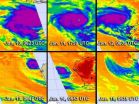(Press-News.org) NEW YORK (January 15, 2013) -- Health care providers and hospitals are being offered up to $27 billion in federal financial incentives to use electronic health records (EHRs) in ways that demonstrably improve the quality of care. The incentives are based, in part, on the ability to electronically report clinical quality measures. By 2014, providers nationwide will be expected to document and report care electronically, and by 2015, they will face financial penalties if they don't meaningfully use EHRs.
A new, federally-funded study by Weill Cornell Medical College in the Jan. 15 issue of Annals of Internal Medicine demonstrates ways in which quality measurement from EHRs -- which are primarily designed for documentation of clinical care for individual patients -- can be improved. In a large cross-sectional study in New York state, researchers demonstrated that the accuracy of quality measures can vary widely. Electronic reporting, although generally accurate, can both underestimate and overestimate quality.
"This study reveals how challenging it is to measure quality in an electronic era. Many measures are accurate, but some need refinement," says the study's senior author, Dr. Rainu Kaushal, director of the Center for Healthcare Informatics Policy, chief of the Division of Quality and Medical Informatics and the Frances and John L. Loeb Professor of Medical Informatics at Weill Cornell.
"Getting electronic quality measurement right is critically important to ensure that we are accurately measuring and incentivizing high performance by physicians so that we ultimately deliver the highest possible quality of care. Many efforts to do this are underway across the country," continues Dr. Kaushal, also a professor of pediatrics, medicine, and public health at Weill Cornell and a pediatrician at the Komansky Center for Children's Health at NewYork-Presbyterian Hospital/Weill Cornell Medical Center.
For this study, Weill Cornell researchers analyzed clinical data from the EHRs of one of the largest community health center networks in New York state. The research team examined the accuracy of electronic reporting for 12 quality measures, 11 of which are included in the federal government's set of measures for incentives. What they found was fairly good consistency for nine measures, but not for the other three.
"The variation in quality measurement that we found in a leading electronic health record system speaks to the need to test and iteratively refine traditional quality measures so that they are suited to the documentation patterns in EHRs," says the study's lead investigator, Dr. Lisa Kern, a general internist and associate director for research at the Center for Healthcare Informatics at Weill Cornell.
The automated reports generally performed well. However, they underestimated the percentage of patients receiving prescriptions for asthma and receiving vaccinations to protect from bacterial pneumonia. A third measure suggested that more patients with diabetes had cholesterol under control than actually did. The automated report said 57 percent of eligible diabetic patients had cholesterol controlled, while a manual check of the charts showed it was actually only 37 percent. Part of the problem is that physicians and nurses filling out the EHRs may be typing in information in a place that is not being captured by quality reporting algorithms.
"EHRs create the opportunity to measure and provide feedback to clinicians regarding quality performance in real time, thereby improving clinical practice," says Dr. Kern, who is also an associate professor of public health and medicine at Weill Cornell.
Dr. Kaushal adds, "EHRs are not just electronic versions of paper records but rather tools that enable transformation in the way care is delivered, documented, measured and improved. The federal meaningful use program will enable the deployment of these promising systems across the country, thereby enabling health care to enter the digital age."
###
This study was funded by the federal Agency for Healthcare Research and Quality and featured in an AHRQ exemplary video, entitled "Developing and Testing Quality Measures for Interoperable Electronic Health Records." To view the video, visit: http://healthit.ahrq.gov/EQMKaushalVideo.
Weill Cornell Medical College
Weill Cornell Medical College, Cornell University's medical school located in New York City, is committed to excellence in research, teaching, patient care and the advancement of the art and science of medicine, locally, nationally and globally. Physicians and scientists of Weill Cornell Medical College are engaged in cutting-edge research from bench to bedside, aimed at unlocking mysteries of the human body in health and sickness and toward developing new treatments and prevention strategies. In its commitment to global health and education, Weill Cornell has a strong presence in places such as Qatar, Tanzania, Haiti, Brazil, Austria and Turkey. Through the historic Weill Cornell Medical College in Qatar, the Medical College is the first in the U.S. to offer its M.D. degree overseas. Weill Cornell is the birthplace of many medical advances -- including the development of the Pap test for cervical cancer, the synthesis of penicillin, the first successful embryo-biopsy pregnancy and birth in the U.S., the first clinical trial of gene therapy for Parkinson's disease, and most recently, the world's first successful use of deep brain stimulation to treat a minimally conscious brain-injured patient. Weill Cornell Medical College is affiliated with NewYork-Presbyterian Hospital, where its faculty provides comprehensive patient care at NewYork-Presbyterian Hospital/Weill Cornell Medical Center. The Medical College is also affiliated with the Methodist Hospital in Houston. For more information, visit weill.cornell.edu.
Researchers identify ways to improve quality of care measurement from electronic health records
New study shows ways quality of care measures can be improved for EHRs
2013-01-16
ELSE PRESS RELEASES FROM THIS DATE:
International study: Where there's smoke or smog, there's climate change
2013-01-16
In addition to causing smoggy skies and chronic coughs, soot – or black carbon – turns out to be the number two contributor to global warming. It's second only to carbon dioxide, according to a four-year assessment by an international panel.
The new study concludes that black carbon, the soot particles in smoke and smog, contributes about twice as much to global warming as previously estimated, even by the 2007 Intergovernmental Panel on Climate Change.
"We were surprised at its potential contribution to climate," said Sarah Doherty, a University of Washington atmospheric ...
New American Chemical Society podcast: Leaves of carob tree fight food-poisoning bacteria
2013-01-16
The latest episode in the American Chemical Society's (ACS') award-winning Global Challenges/Chemistry Solutions podcast series reports that an antibacterial extract from the leaves of the carob tree (the source of a popular chocolate substitute) could fight the microbe responsible for the serious form of food poisoning called listeriosis.
Based on a report by Pierluigi Caboni, Ph.D., Nadhem Aissani and colleagues in ACS' Journal of Agricultural and Food Chemistry, the new podcast is available without charge at iTunes and from www.acs.org/globalchallenges.
In the ...
Novel approach to track migration of arctic-breeding avian species
2013-01-16
Animals move around the globe in billions, sometimes - like the snow bunting - one of the iconic Arctic-breeding species, covering huge distances and enduring the most extreme frigid weather conditions. In this conspicuously white sparrow-sized bird, animal migration epitomizes a stunning success of biological adaptation – with Snow Bunting representing the only songbird to breed as far north as the Arctic Circle. Indeed, there is nothing north of the snow bunting's breeding ground except the North Pole and the polar ice cap. These passerines thrive in chilly, alpine conditions, ...
Studies provide new insights into brain-behavior relationships
2013-01-16
Amsterdam, NL, January 15, 2013 – Approximately half a million individuals suffer strokes in the US each year, and about one in five develops some form of post-stroke aphasia, the partial or total loss of the ability to communicate. By comparing different types of aphasia, investigators have been able to gain new insights into the normal cognitive processes underlying language, as well as the potential response to interventions. Their findings are published alongside papers on hemispatial neglect and related disorders in the January, 2013 issue of.
The January issue of ...
NASA finds 2012 sustained long-term climate warming trend
2013-01-16
NASA scientists say 2012 was the ninth warmest of any year since 1880, continuing a long-term trend of rising global temperatures. With the exception of 1998, the nine warmest years in the 132-year record all have occurred since 2000, with 2010 and 2005 ranking as the hottest years on record.
NASA's Goddard Institute for Space Studies (GISS) in New York, which monitors global surface temperatures on an ongoing basis, released an updated analysis Tuesday that compares temperatures around the globe in 2012 to the average global temperature from the mid-20th century. The ...
Choline supplementation during pregnancy presents a new approach to schizophrenia prevention
2013-01-16
AURORA, Colo. (Jan. 15, 2013) — Choline, an essential nutrient similar to the B vitamin and found in foods such as liver, muscle meats, fish, nuts and eggs, when given as a dietary supplement in the last two trimesters of pregnancy and in early infancy, is showing a lower rate of physiological schizophrenic risk factors in infants 33 days old. The study breaks new ground both in its potentially therapeutic findings and in its strategy to target markers of schizophrenia long before the illness itself actually appears. Choline is also being studied for potential benefits ...
Infrared NASA imagery shows sinking air, elongation in Tropical Storm Emang
2013-01-16
The Atmospheric Infrared Sounder instrument that flies on NASA's Aqua satellite provides valuable data to tropical cyclone forecasters, and revealed sinking air, a small area of powerful thunderstorms, and a slightly elongated Tropical Storm Emang.
Infrared data on Tropical Storm Emang's cloud top temperatures was captured by the Atmospheric Infrared Sounder (AIRS) instrument on Jan. 15 at 0823 UTC (3:23 a.m. EST). AIRS data showed that the largest area of powerful thunderstorms were in the northern half of the storm. That area showed cold cloud top temperatures of -63F ...
NASA satellites see Cyclone Narelle torn apart
2013-01-16
NASA's TRMM and Aqua satellites showed how Tropical Cyclone Narelle has fallen far from being a powerful cyclone in the Southern Indian Ocean. A time series of infrared images from an Aqua satellite instrument provides a clear picture of Narelle's former power and its recent demise, while TRMM 3-D data showed falling cloud heights and weaker rainfall.
Narelle, once a powerful tropical cyclone with winds of 115 knots (~132 mph), was equivalent to a category 4 hurricane on the Saffir-Simpson scale. The storm has continued to steadily weaken as it made its way southward ...
Surgical-site infections may increase risk of deadly blood clots after colorectal surgery
2013-01-16
Despite receiving blood thinners and other clot prevention treatment, some patients still develop potentially lethal blood clots in the first month after their operations anyway, especially if they developed a surgical-site infection while in the hospital, according to results of a study at Johns Hopkins.
The research, described in a report published in the Journal of the American College of Surgeons, found that patients who experience a surgical-site infection after their abdominal surgery are four times more likely than infection-free patients to develop a deep-vein ...
Judge's Ruling Could Affect Guture Chapter 7 Means Tests
2013-01-16
Judge's ruling could affect future Chapter 7 means tests
In November 2012, a federal bankruptcy judge in Florida issued a ruling that challenges the conventional wisdom regarding the means test when a bankruptcy filer converts his or her bankruptcyfrom a Chapter 13 to a Chapter 7.
Defining Chapter 13, Chapter 7 and means testing
Before delving into the bankruptcy judge's decision, it is important to understand a few key bankruptcy concepts. Chapter 13 and Chapter 7 bankruptcies are both ways for filers to relieve themselves of the burden of their debts. Chapter ...
LAST 30 PRESS RELEASES:
New expert guidance urges caution before surgery for patients with treatment-resistant constipation
Solar hydrogen can now be produced efficiently without the scarce metal platinum
Sleeping in on weekends may help boost teens’ mental health
Study: Teens use cellphones for an hour a day at school
After more than two years of war, Palestinian children are hungry, denied education and “like the living dead”
The untold story of life with Prader-Willi syndrome - according to the siblings who live it
How the parasite that ‘gave up sex’ found more hosts – and why its victory won’t last
When is it time to jump? The boiling frog problem of AI use in physics education
Twitter data reveals partisan divide in understanding why pollen season's getting worse
AI is quick but risky for updating old software
Revolutionizing biosecurity: new multi-omics framework to transform invasive species management
From ancient herb to modern medicine: new review unveils the multi-targeted healing potential of Borago officinalis
Building a global scientific community: Biological Diversity Journal announces dual recruitment of Editorial Board and Youth Editorial Board members
Microbes that break down antibiotics help protect ecosystems under drug pollution
Smart biochar that remembers pollutants offers a new way to clean water and recycle biomass
Rice genes matter more than domestication in shaping plant microbiomes
Ticking time bomb: Some farmers report as many as 70 tick encounters over a 6-month period
Turning garden and crop waste into plastics
Scientists discover ‘platypus galaxies’ in the early universe
Seeing thyroid cancer in a new light: when AI meets label-free imaging in the operating room
Neutrophil-to-lymphocyte ratio may aid risk stratification in depressive disorder
2026 Seismological Society of America Annual Meeting
AI-powered ECG analysis offers promising path for early detection of chronic obstructive pulmonary disease, says Mount Sinai researchers
GIMM uncovers flaws in lab-grown heart cells and paves the way for improved treatments
Cracking the evolutionary code of sleep
Medications could help the aging brain cope with surgery, memory impairment
Back pain linked to worse sleep years later in men over 65, according to study
CDC urges ‘shared decision-making’ on some childhood vaccines; many unclear about what that means
New research finds that an ‘equal treatment’ approach to economic opportunity advertising can backfire
Researchers create shape-shifting, self-navigating microparticles
[Press-News.org] Researchers identify ways to improve quality of care measurement from electronic health recordsNew study shows ways quality of care measures can be improved for EHRs



